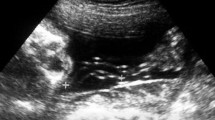Abstract
Background
The umbilical cord is the lifeline of the foetus as it supplies water, nutrients, and oxygen. Protection of these blood vessels is needed and provided by Wharton’s Jelly, amniotic fluid and the helical pattern, or coiling, of the umbilical cord vessels.
Aim
To establish the relationship between antenatal umbilical cord coiling index (aUCI) measured at 18–20 weeks along with level II USG and adverse perinatal outcomes.
Methods
A cross-sectional study was conducted on 408 antenatal women, enrolled at the time of fetal anatomic survey, and their cord coiling index (aUCI) was measured, and its association with perinatal outcomes was observed. Umbilical coiling index was classified as Hypocoiled if UCI <10th percentile, hypercoiled >90th percentile, normocoiled between 10th and 90th percentile.
Results
408 antenatal women were enrolled for the study. Mean aUCI was 0.43 ± 0.30 (normocoiled group), 0.18 ± 0.4 (hypocoiled), and 0.53 ± 0.05 (hypercoiled group). The average gestational age at delivery in hypocoiled group was 36.8 ± 2.34 weeks, and it was shorter than 38.3 ± 1.82 weeks of the normocoiled group and 38.9 ± 1.72 weeks of the hypercoiled group. Mean birth weight observed was 2055 ± 744 (hypocoiled group), 3049 ± 564 (hypercoiled), and 3102 ± 564 (normocoiled) p < 0.001. Preterm births 52 (59%) and low birth weight 76 (69%) were significantly associated with hypocoiling.
Conclusion
Abnormal umbilical cord coiling index, detected at the fetal ultrasound anatomic survey in the second trimester (18–20 weeks), can be used potentially as a screening or as a predictive tool for adverse antenatal or perinatal events.

Similar content being viewed by others
References
Sharma B, Bhardwaj N, Gupta S et al. Association of umbilical coiling index by colour Doppler ultrasonography at 18 to 22 weeks of gestation and perinatal outcome. J Obstet Gynecol India. 2012;62(6):650–4.
Muckle C, Feinberg E. Developmental abnormalities of the female reproductive organs. Glob Libr Women’s Med. (ISSN: 1756-2228) 2008; doi:10.3843/GLOWM.10002.
De Laat MW, Nikkels PG, Franx A, Visser GH. The roach muscle bundle and umbilical cord coiling. Early Hum Dev. 2007;83:571–4.
Diwakar RK, Naik MM, Jindal MM. Umbilical cord coiling: case report and review of literature. BJR Case Rep. 2016;2:20150152.
Proctor LK, Fitzgerald B, Whittle WL, et al. Umbilical cord diameter percentile curves and their correlation to birth weight and placental pathology. Placenta. 2013;34(1):62–6.
Abdulrasul EA. Umbilical coiling index as a predictor of adverse perinatal outcome. Int J Adv Res. 2014;2:101–7.
Chitra T, Sushanth YS, Raghavan S. Umbilical coiling index as a marker of perinatal outcome: an analytical study. Obstet Gynecol Int 2012; 2012. Article ID 213689. doi:10.1155/2012/213689.
Sebire NJ. Pathophysiological significance of abnormal umbilical cord coiling index. Ultrasound Obstet Gynecol. 2007;30:804–6.
Clerici G, Antonelli C, Rizzo G, Kanninen TT, Di Renzo GC. Atypical hemodynamic pattern in fetuses with hypercoiled umbilical cord and growth restriction. J Matern Fetal Neonatal Med. 2013;26(6):558–62.
American College of Obstetricians and Gynaecologists Committee on practice Bulletins-Obstetrics. ACOG practice bulletin No. 98. Ultrasonography in pregnancy. Obstet Gynecol 2008; 112: 951–61.
Jo YS, Jang DK, Lee G. The sonographic umbilical cord coiling in late second trimester of gestation and perinatal outcomes. Int J Med Sci. 2011;8(7):594–8.
Mittal A, Nanda S, Sen J. Antenatal umbilical coiling index as a predictor of perinatal outcome. Arch Gynecol Obstet. 2015;291:763–8.
Tahmasebi M, Alighambari R. Evaluation of umbilical cord thickness, cross sectional area, and coiling index as predictors of pregnancy outcome. Indian J Radiol Imaging. 2011;21:195–8.
Goynumer G, Ozdemir A, Wetherilt L, Durukan B, Yayla M. Umbilical cord thickness in the first and early second trimester and perinatal outcome. J Perinat Med. 2008;36:523–6.
Author information
Authors and Affiliations
Corresponding author
Ethics declarations
Conflicts of interest
All the authors declare that they have no conflict of interest.
Ethical Statements
Prior ethical clearance was obtained from Institutional Ethical Committee—Human Research of our institution.
Additional information
Richa Sharma is an Assistant Professor in the Department of Obstetrics and Gynecology, University College of Medical Sciences and Guru Teg Bahadur Hospital, New Delhi; Gita Radhakrishnan is a Director Professor in the Department of Obstetrics and Gynecology, University College of Medical Sciences and Guru Teg Bahadur Hospital, New Delhi; Smita Manchanda is an Assistant Professor in the Department of Radiodiagnosis, University College of Medical Sciences and Guru Teg Bahadur Hospital, New Delhi; Shilpa Singh is a Senior Resident in the Department of Obstetrics and Gynecology, University College of Medical Sciences and Guru Teg Bahadur Hospital, New Delhi.
Rights and permissions
About this article
Cite this article
Sharma, R., Radhakrishnan, G., Manchanda, S. et al. Umbilical Coiling Index Assessment During Routine Fetal Anatomic Survey: A Screening Tool for Fetuses at Risk. J Obstet Gynecol India 68, 369–375 (2018). https://doi.org/10.1007/s13224-017-1046-8
Received:
Accepted:
Published:
Issue Date:
DOI: https://doi.org/10.1007/s13224-017-1046-8




